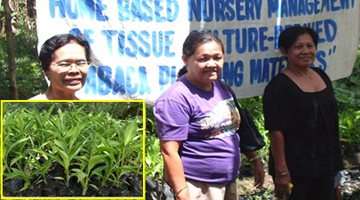 TINIWISAN, Butuan City - “We have fun bonding with each other and we earn extra money for our RIC projects”. Thus justified, Myrna Balisbis and about 20 other women of the Tiniwisan Rural Improvement Club (RIC) remain committed to helping the Caraga State University (CSU) in its efforts to expand abaca plantations in the region.
TINIWISAN, Butuan City - “We have fun bonding with each other and we earn extra money for our RIC projects”. Thus justified, Myrna Balisbis and about 20 other women of the Tiniwisan Rural Improvement Club (RIC) remain committed to helping the Caraga State University (CSU) in its efforts to expand abaca plantations in the region.
Specifically, the Tiniwisan RIC rear tissue-cultured seedlings from test tube plantlets for the CSU Tissue Culture Laboratory.
Once they get the plantlets, they prepare the outgrowing medium; place the plantlets into plastic pots; and then care for the seedlings for the next three months. Following the protocol they learned from their CSU partners, they can handle at most 5,000 seedlings per cycle. They are currently on their third cycle.
The program started out under the impetus of Barangay Captain Demetrio E. Tabelon. As a farmer and successful entrepreneur himself, he encouraged the women to become involved in worthwhile projects. So far, the women are not complaining. Incidentally, Tabelon is a farmer-cooperator in a Philippine Council for Agriculture, Aquatic and Natural Resources Research and Development (PCAARRD)-funded project on banana.
After the three-month growing period, CSU buys back the seedlings from the RIC for P1.50 each. Balisbis, project focal person, boasts that their income has financed several programs to date. These include feeding of children, construction of sanitary toilets, and procurement of supplies and materials for their office.
CSU Vice President for Research and Extension Rowena Varela shares that this program, “Home-based nursery management of tissue-cultured abaca planting materials”, forms part of the University’s Gender and Development Program. Through this program, the CSU provides the Tiniwisan women an alternative activity for their time and get them involved in worthy community projects.
She praises the women for their ability to follow the protocol successfully and their commitment to the success of the program. Because of these, Varela reveals that the University might tap the women again for the production of banana planting materials, especially to support the local need for Cardaba banana.
This writer teased the RIC representatives that pretty soon, they could be charging CSU and even private buyers a premium fee. Without second thoughts, they said that could be a reality soon enough as some of their members are planning to set up their own nurseries.
CSU has proven once again that when women are truly empowered, they become a potent force for development in the community. With more projects coming their way, the women of Tiniwisan may well become models for their sisters in Butuan City and the Caraga Region.
